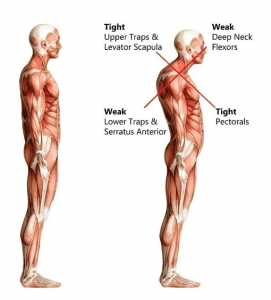Physical Address
304 North Cardinal St.
Dorchester Center, MA 02124
Physical Address
304 North Cardinal St.
Dorchester Center, MA 02124

Table of Contents
The term Upper Cross Syndrome refers to a specific posture that is often observed in our technological culture today: the head protrudes forward, the shoulders fall and the roundness of the upper back. This posture can make you uncomfortable while sitting, walking or even sleeping.
In this article, I will talk about the upper cross syndrome, its causes, treatment, prevention, and upper cross syndrome sleep position.
The upper cross syndrome refers to a particular pattern of overlapping of hyperactive and inactive muscle groups in the neck, chest, and shoulders.

With upper cross syndrome, the muscles in the shoulders, neck, and chest become deformed. More specifically, the muscles of the back of the neck and shoulders (upper trapezius and levator scapula) become extremely hyperactive and tense. The muscles in the front of the chest (the major and minor pectoral muscles) are shortened and tightened.
As a result of these overactive muscles, the surrounding opposing muscles become underused and weakened. In upper cross syndrome, this causes weak muscles in the front of the neck (cervical flexor muscles) and the lower shoulders (rhomboid muscles and lower trapezoids).
The condition gets its name from the “x” shape that develops when the overactive and inactive muscle regions overlap.
Poor posture usually causes the syndrome, including head forward posture, which occurs when people use electronic devices, read and drive. People with upper crossing syndrome usually have a set of identical or similar postural irregularities that people can describe as slouching.
There are many stretching and strengthening exercises that generally provide relief from the symptoms of the upper cross syndrome.
You May Also Like
Can bad posture cause dizziness?

The upper cross syndrome can be caused by bad posture. It all depends on your postural habits! Sitting, standing, sleeping and technological habits!
Different movements can cause the upper cross syndrome, but most cases develop due to poor posture, especially sitting or standing with your head forward for extended periods.
Most of these bad habits revolve around technology. If you think about it, the car, the phone, the computers, the television, the couches, etc. create the need to sit.
We are spending more time than ever sitting, slouching working/playing on our phones, computers, tablets or in our vehicles. It is not that the sitting position is bad, but the chronic sitting position. Chronic poor sitting posture builds up to create early degeneration, arthritis, osteoporosis, pain, headaches, neurological dysfunction, etc.
Activities that promote this postural position include:

In some cases, congenital injuries or disabilities can also contribute to the development or creation of the disease.
Sitting for short periods is not the problem. It is a chronic sitting that creates chronically shorter and tighter flexor muscles in the hip and back. Naturally, these muscles are short when seated. The longer and more often you sit, the shorter and tighter these muscles will be. These muscles, when short and tense, will create a lower crossing syndrome type posture which can contribute to an altered center of gravity and increase the likelihood of creating a higher crossing syndrome type posture. When a person has both postural dysfunctions, this is called Layered syndrome. It is much more difficult to solve than having one or the other.
Sitting in poor posture greatly increases the chances of having Layered syndrome. Poor sitting posture, such as rounding the shoulders and upper spine forward, looking down and stretching the head forward, directly contributes to the upper cross syndrome. These positions that create these postures are not the enemy, the chronicity of the postures is.
Standing like sitting is not the problem rather standing up with bad posture habits is. Do you allow your head and neck to move forward or are you in an upright position?
You have to be taught to stand straight as if you had a rope at the top of your head that lifts you off your feet. This allows you to lengthen the neck upward rather than forward. The pull of the imaginary cord also discourages the anterior pelvic tilt seen in lower cross syndrome. It is difficult to have bad posture when you practice this technical rope.
You May Also Like
When you decide to lie down after hours, days and months sitting and standing with poor posture, its shape also retains its effects on the body. This generally makes the fetal position comfortable. It mimics your sitting posture by allowing the same muscles to stay short and tight and others long and weak. Sleeping on your stomach can have similar empowering effects on these short back muscles and long abdominal muscles. Sleeping on your back is the best anatomically correct sleeping position. Again, it’s not that the positions are bad for a short time. It is the chronicity in which you use the positions that is bad.
Ideally, we would sleep on our backs most of the night. It is imperative not to stack pillows when watching TV or when using your phone in bed. Avoid falling asleep with your head tilted forward under 2 or 3 pillows.
Joint Stacking: As I have mentioned before, your standing habits can cause the cross syndrome. The anterior pelvic tilt created in this position often changes your center of gravity, causing your thoracic spine to increase its curvature opposite that of your increased lumbar curvature.
This displacement tends to push the head forward to concentrate gravity on the upper end and down below the knees. Usually, you will also have more weight on the sole because of this. This often leads to tight calves and therefore plantar fasciitis. The type described above is more of a joint stacking of the sagittal plane.
Of course, stacking can be done in a seated position, such as leaning on the center console while driving. This type of postural behavior can be applied to almost any postural position, just use your imagination.
You May Also Like
How long does it take to fix your posture?
It’s not that technology is bad, but with the use of certain technologies, we need to change our ergonomics. With the invention of the chair, the idea of the ergonomics of the chair came. Which ergonomic seat is best? Sitting on the floor or on a chair? How about using the bathroom or squatting?
One of our best research on the subject so far is that our ancestors were right. In our modern and advanced era, you see new inventions geared toward our primitive health while maintaining the status quo of our society. Take a look at some of these new ideas, such as the Squatty jar which allows for a better posture when you are in the bathroom. The Veridesk, which allows you to get up rather than sit down and continue the dialing these numbers on your keyboard.
Common features of the upper cross syndrome include:
You May Also Like
The deformed muscles associated with upper cross syndrome put pressure on the surrounding muscles, tendons, bones, and joints, causing symptoms in most people such as:
The upper cross syndrome has several identifying features that your doctor will recognize. This includes:
If these physical characteristics are present and you also experience symptoms of Upper cross syndrome, your doctor will diagnose the condition.
You May Also Like
Poor posture and movement efficiency

When you have the upper cross syndrome, the body retains the shape and effects even when you lie down. The body tries to copy your sitting posture thus making the muscle to remain short and tight while others lengthen and weaken.
The best upper cross syndrome sleep position is to lie o your back. Like I said earlier, it is the best way to lie down anatomically. Therefore, it is the recommended upper cross syndrome sleep position.
Others may think sleeping on the stomach is the correct upper cross syndrome sleep position. Here’s the thing, sleeping on your stomach will have the same effects on the short back muscles and the long abdominal muscles.
Therefore, I can say that the correct upper cross syndrome sleep position is lying or sleeping on your back.
Treatment options for the upper cross syndrome are chiropractic care, physiotherapy, and exercise. Generally, a combination of the three is recommended.
Tense muscles and poor posture produced by upper cross syndrome can cause joint misalignment. A chiropractic adjustment by a licensed professional can help realign these joints. This can increase the range of motion in the affected areas. An adjustment also generally stretches and relaxes the shortened muscles.
A physiotherapist uses a combination of approaches. First, they offer education and advice related to your condition, like why it happened and how to prevent it in the future. They will demonstrate and practice exercises that you should continue with at home. They also use manual therapy, where they use their hands to relieve pain and stiffness and promote better body movement.
You May Also Like
Can poor posture cause arthritis?
To counter the tension that affects the muscles affected by the upper cross syndrome, we need to open the chest, the anterior deltoids (front of the shoulders), the upper trapezius and the scapula, as well as strengthen the flexors of the neck, the middle trapezius and lower, rhomboids and serrated anterior.
We want to start by cultivating more mobility in the right places. Stability arises from a properly functioning proprioception (your body’s perception of its movements and spatial orientation), and proprioception cannot function properly if there are mobility limitations.
Exercises can help correct your upper cross syndrome by increasing mobility in the right places.
The best way to treat upper cross syndrome is with exercise and postural changes. Although some people may experience a lot of discomfort during stretching, it is important that they try some kind of light exercise, as restricting activity can cause stiffness and pain.
People should make sure to warm up before exercising, either by gentle, gradual movements or by taking a hot bath or shower. Start all the exercises slowly and then increase slowly.
You May Also Like
Lying Exercises
The recommended lying exercise for the upper cross syndrome is similar to the yoga corpse pose, but with a pillow supporting your back.
Lie down with something like a thick pillow placed around a third of your back, aligned with your spine. Let your shoulders and arms stretch and loosen and your legs extend naturally.
Make sure your head is neutral and doesn’t feel tense or stretched. If yes, use a pillow or support.
Stay in this position for 10 to 15 minutes and repeat the exercise several times a day.
Sitting Exercises
The sitting exercise is similar to a seated version of the staff pose in yoga.
Sit with your back straight, bend your knees with your feet flat on the floor. Press your palms on the floor behind your hips and roll your shoulders down and back. You should feel the tight muscles in your neck, shoulders and chest stretch.
For more chest stretching, push your palms to the floor without moving them.
Stay in this position for 3 to 5 minutes, or as long as you feel comfortable. Repeat the exercise several times during the day.
Standing Exercises
Stand with your feet about 3 to 4 feet apart. Keeping the torso fixed where it is, rotate the right foot 90 degrees and rotate the left foot inward at an angle of about 30 degrees.
With your palms down, place your arms at shoulder height in line with your legs.
Keep your left leg and torso straight, turn your head to look at your right toes and bend your right knee as much as possible, but not more than 90 degrees.
You May Also Like
Poor posture and lower back pain – Ultimate Relationship
You can also use braces to improve your posture and correct upper cross syndrome. Below are some that I recommend.
1. The Backpod
Click on this link to view details.
2. PostureMedic Original
To view product details click here.
3. Solid Back Pillow Cushion and Brace Product Alternative
To view the product click here.
The best way to prevent and treat upper cross syndrome is to avoid activities that involve stretching your head forward for long periods.
Other tips to prevent upper cross syndrome include:
Correcting or practicing good posture is also an important element in avoiding and treating the upper cross syndrome.
The upper cross syndrome is generally an avoidable condition. Practicing good posture is of vital importance in preventing and treating the disease. Be aware of your posture and correct it if you are in the wrong position.
The symptoms of Upper cross syndrome can often be completely alleviated or eradicated with treatment. Some people suffer from this disease repeatedly throughout their life, but this is usually due to the fact that they do not follow their exercise program or pay attention to their posture daily.
When Upper cross syndrome individualized treatment plans are followed with precision, this is a completely manageable condition.